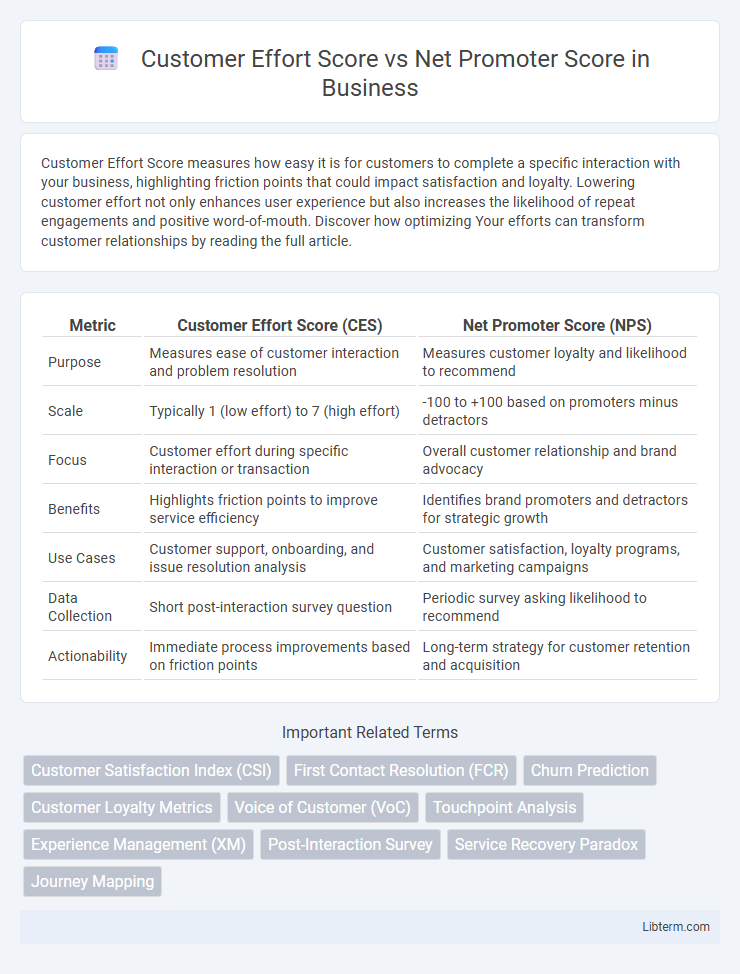Customer Effort Score measures how easy it is for customers to complete a specific interaction with your business, highlighting friction points that could impact satisfaction and loyalty. Lowering customer effort not only enhances user experience but also increases the likelihood of repeat engagements and positive word-of-mouth. Discover how optimizing Your efforts can transform customer relationships by reading the full article.
Table of Comparison
| Metric | Customer Effort Score (CES) | Net Promoter Score (NPS) |
|---|---|---|
| Purpose | Measures ease of customer interaction and problem resolution | Measures customer loyalty and likelihood to recommend |
| Scale | Typically 1 (low effort) to 7 (high effort) | -100 to +100 based on promoters minus detractors |
| Focus | Customer effort during specific interaction or transaction | Overall customer relationship and brand advocacy |
| Benefits | Highlights friction points to improve service efficiency | Identifies brand promoters and detractors for strategic growth |
| Use Cases | Customer support, onboarding, and issue resolution analysis | Customer satisfaction, loyalty programs, and marketing campaigns |
| Data Collection | Short post-interaction survey question | Periodic survey asking likelihood to recommend |
| Actionability | Immediate process improvements based on friction points | Long-term strategy for customer retention and acquisition |
Introduction to Customer Effort Score and Net Promoter Score
Customer Effort Score (CES) measures the ease of customer interactions with a company, focusing on reducing friction in the customer journey to improve satisfaction and loyalty. Net Promoter Score (NPS) evaluates customer loyalty by assessing the likelihood of customers recommending a brand to others, serving as a key indicator of overall brand advocacy and growth potential. Both CES and NPS provide valuable insights for businesses to optimize customer experience and drive long-term success.
Defining Customer Effort Score (CES)
Customer Effort Score (CES) measures the ease of customer interactions with a brand, quantifying how much effort customers exert to resolve issues or complete tasks. Unlike Net Promoter Score (NPS), which gauges overall customer loyalty and likelihood to recommend, CES focuses specifically on friction points within the customer journey. Companies use CES to identify and reduce obstacles, enhancing customer satisfaction and retention by streamlining service efficiency.
Defining Net Promoter Score (NPS)
Net Promoter Score (NPS) measures customer loyalty by asking how likely customers are to recommend a company on a scale from 0 to 10, categorizing responses into promoters, passives, and detractors. This metric identifies overall customer sentiment and predicts business growth by quantifying brand advocacy. NPS provides a clear indication of customer satisfaction and long-term revenue potential, making it a key performance indicator in customer experience management.
Key Differences Between CES and NPS
Customer Effort Score (CES) measures the ease of customer interactions and problem resolution, emphasizing the reduction of friction in customer experience, whereas Net Promoter Score (NPS) gauges customer loyalty and the likelihood of brand recommendation. CES focuses on short-term transactional feedback to improve immediate service touchpoints, while NPS assesses long-term customer satisfaction and promotes business growth strategies. The key difference lies in CES targeting operational efficiency and NPS targeting customer advocacy and overall brand perception.
How to Measure Customer Effort Score
Measuring Customer Effort Score (CES) involves asking customers to rate the ease of their experience with a specific interaction, usually on a scale from "very difficult" to "very easy." This metric directly quantifies the effort required to complete a task, such as resolving an issue, making a purchase, or finding information. Collecting CES data immediately after the interaction helps businesses identify friction points and improve customer satisfaction more effectively than broader loyalty metrics like Net Promoter Score (NPS).
How to Measure Net Promoter Score
Net Promoter Score (NPS) is measured by asking customers a single question: "On a scale from 0 to 10, how likely are you to recommend our product or service to a friend or colleague?" Respondents are categorized into Promoters (9-10), Passives (7-8), and Detractors (0-6), and NPS is calculated by subtracting the percentage of Detractors from the percentage of Promoters. This simple scoring system provides a clear metric for gauging customer loyalty and predicting business growth.
Advantages of Using CES
Customer Effort Score (CES) measures the ease of customer interaction with a company, enabling businesses to identify and reduce friction in the customer journey effectively. Unlike Net Promoter Score (NPS), which gauges overall loyalty and likelihood to recommend, CES provides immediate insights into specific pain points, driving targeted improvements that enhance customer satisfaction. Using CES helps companies decrease customer effort, leading to higher retention rates and stronger long-term relationships.
Benefits of Implementing NPS
Net Promoter Score (NPS) directly measures customer loyalty by categorizing customers into promoters, passives, and detractors, providing clear insights into brand advocacy and potential growth opportunities. Implementing NPS facilitates targeted improvements in customer experience, driving higher retention rates and increasing word-of-mouth referrals. Leveraging NPS data enables businesses to prioritize strategies that enhance customer satisfaction, ultimately boosting revenue and competitive advantage.
When to Use CES vs. NPS
Customer Effort Score (CES) is most effective for measuring the ease of specific interactions or transactions, helping businesses identify friction points in customer service or product use. Net Promoter Score (NPS) is better suited for gauging overall brand loyalty and long-term customer satisfaction by assessing the likelihood of customers recommending the company. Use CES during or immediately after customer interactions for actionable insights, while NPS is ideal for periodic surveys aimed at tracking brand perception and advocacy over time.
Choosing the Right Metric for Your Business
Customer Effort Score (CES) measures the ease of customer interactions, helping businesses identify friction points, while Net Promoter Score (NPS) gauges overall loyalty and likelihood of recommending the brand. Selecting the right metric depends on your business goals: CES is ideal for improving customer service efficiency, whereas NPS provides insights into long-term customer satisfaction and growth potential. Analyzing customer journey stages and feedback objectives ensures the chosen metric aligns with strategic priorities and drives actionable improvements.
Customer Effort Score Infographic

 libterm.com
libterm.com